Agriculture Secretary Brooke Rollins said on Tuesday that the Trump administration will announce a 'bridge payment' for farmers next week that is designed to provide short-term relief while longer trade…
Derecho and Drought Take Toll on Corn
Bloomberg writers Michael Hirtzer, Dominic Carey, and Kim Chipman reported last week that, “The corn crop in the U.S. Midwest deteriorated the most in 8 years with hot weather adding to woes from drought and the Aug. 10 derecho windstorm that swept through the top-growing state of Iowa.
“Crop ratings of ‘good’ or ‘excellent’ fell by 5 percentage points to 64%, the U.S. Department of Agriculture said on [August 24th]. Ratings fell in 16 of the 18 states monitored by the agency.
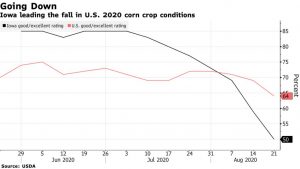
“While experts were still assessing damage from the wind storm that flattened corn fields in central and east-central Iowa, arid weather was taking a toll elsewhere. That could mean American farmers won’t harvest the record-large corn crop USDA predicted on Aug. 12.”
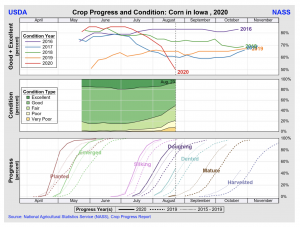
Also last week, Financial Times writer Emiko Terazono reported that, “[Corn] prices had already received a boost after crops were damaged during a storm on August 10 that hit Iowa, a key corn-growing state.
The latest concern, however, has been the low rainfall in the US corn belt throughout August, a situation that is expected to continue for the rest of the week.
And on Tuesday, Associated Press writer David Pitt reported that, “Corn damage [in Iowa] varies. Some fields battered by hail and wind have nothing remaining but sticks poking out of the ground. Others are oddly flattened with 8-foot-tall (2.4-meters-tall) stalks lying in the dirt, broken off or bent so severely that the plants are turning brown. Many in the path of the storm’s strongest blasts still stand but lean eastward at severe angles.
“About 95% of Iowa’s corn crop was insured. The mix of damage means insurance adjusters will write off some fields as a total loss while others will harvest something, but much less than they had expected.”
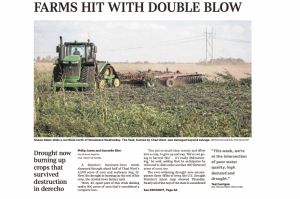
Writing on the front page of Friday’s Des Moines Register, Philip Joens and Donnelle Eller reported that, “The ever-widening drought now encompasses three-fifths of Iowa, the U.S. Drought Monitor’s latest map showed Thursday. Nearly all of the rest of the state is considered abnormally dry, with only a few pockets of Iowa escaping both the drought and derecho.

“Over the past week, Iowa saw temperatures soar to nearly 100 degrees, baking corn and soybean fields, many already damaged by the storm. Some rain-starved Iowa cities — such as Carroll and Audubon — have recorded about a foot less annual precipitation than average.
Justin Glisan, the state climatologist, said Thursday that the growing drought in Iowa is the most severe since one that spanned 151 weeks from 2011-14.
The Register writers explained that, “This year’s drought will most likely push farmers into fields by mid-September, about two weeks earlier than normal, to combine corn and soybeans that the adverse weather is driving to maturity faster, though with lower yields.
“Lower temperatures and a chance of rain are forecast in the days ahead, but any precipitation is likely to be too late to provide much help.”
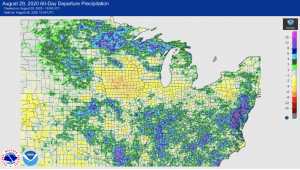
Also last week, Reuters writer Tom Polansek reported that, “Iowa, the biggest U.S. corn-producing state, is facing its most widespread drought since September 2013, state agriculture secretary Mike Naig said on Friday, compounding problems for farmers after a damaging windstorm.
“The drought threatens to lower crop yields and grain quality even more for farmers who are also struggling with ripple effects from the COVID-19 pandemic. The scope of the losses will be determined by whether the state remains painfully dry, according to crop experts.
“Iowa corn is key for commodity markets and global food supply chains. A big loss in the state could trim U.S. production at a time when China is buying more of the grain.”
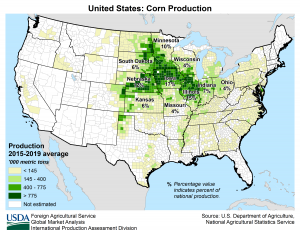
Mr. Polansek pointed out that, “The U.S. Drought Monitor, prepared by a consortium of climatologists, said 96% of Iowa was abnormally dry as of Tuesday, up from 88% a week earlier. About 61% of the state is in a moderate to exceptional drought, up from 45% a week ago.”
And Reuters writer Karl Plume reported last week that, “The U.S. agricultural sector was spared a direct hit from Hurricane Laura on Thursday as the storm veered west of grain export terminals in New Orleans and missed many fields of unharvested cotton and sugar, according to meteorologists and industry sources.
So far bupkus for the driest areas of the Corn Belt from Laura https://t.co/FyHaGRyH8c
— Scott Irwin (@ScottIrwinUI) August 29, 2020
“The storm’s rains, however, are also projected to miss many of the driest areas of the U.S. Midwest corn and soybean belt that need them, including key producers Iowa and Nebraska, they said.”
Mr. Plume added that, “Crops in places like Iowa, Illinois and Indiana have shriveled due to hot and dry weather during August. The heatwave, which hit as soybeans were progressing through their critical pod filling phase of development, has lowered forecasts for what was expected to be a record corn crop.”





